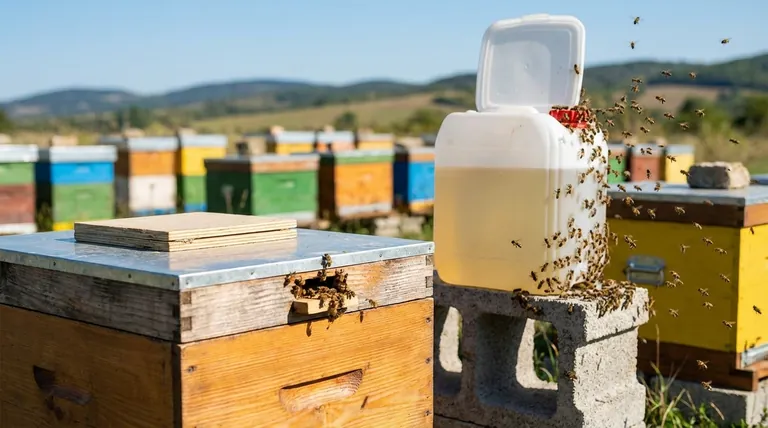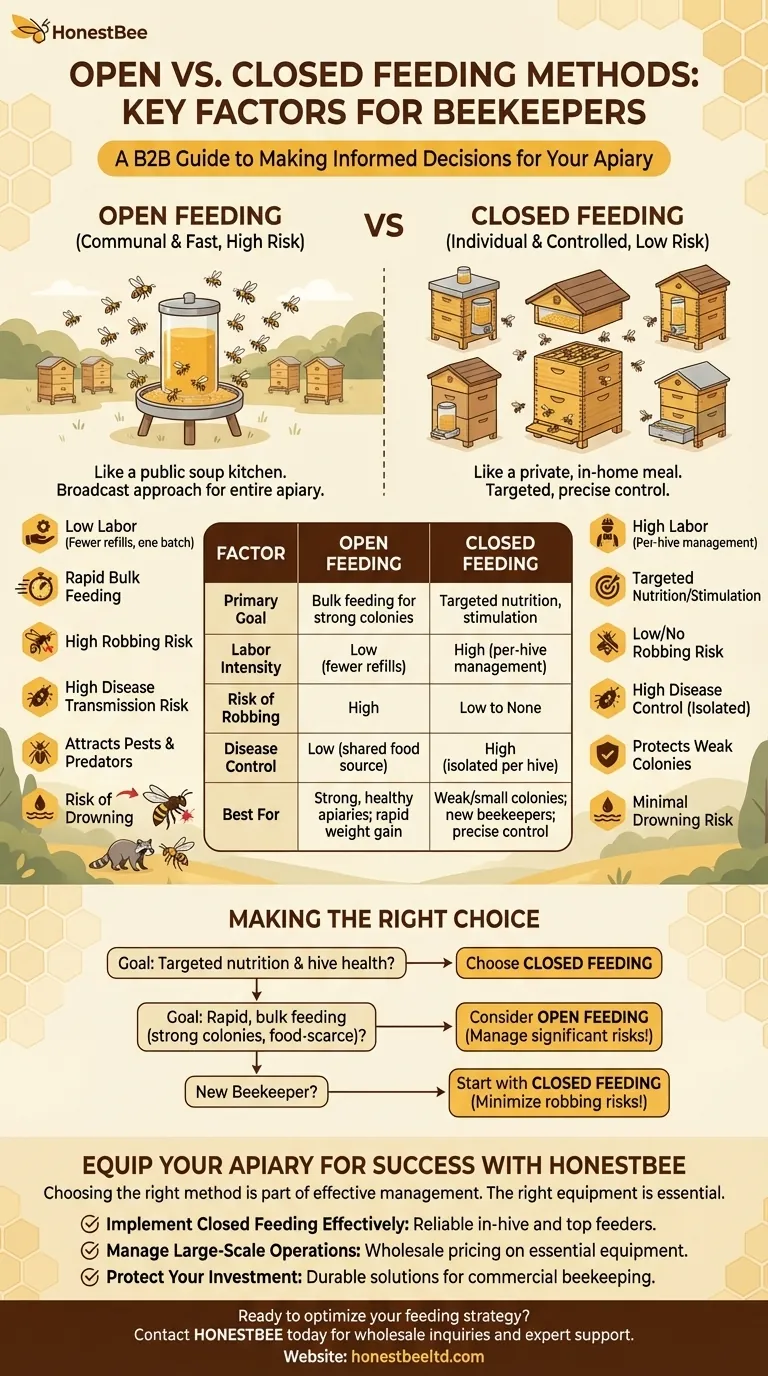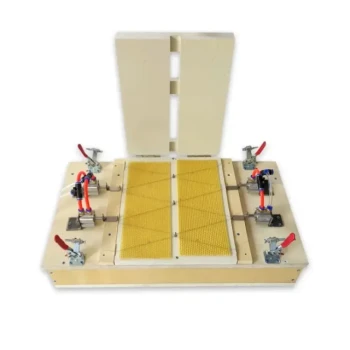Choosing between open and closed bee feeding is a fundamental decision in apiary management that directly impacts colony health, your workload, and your budget. The right choice depends on your specific goals for feeding, the time you can commit, the strength of your colonies, and the level of risk you are willing to assume.
The core decision is not about which feeding method is universally better, but which is more appropriate for a specific situation. Closed feeding provides control and protection for individual hives, while open feeding offers speed and convenience for the entire apiary at the cost of significant risks.

The Core Difference: Control vs. Convenience
Understanding the fundamental purpose and mechanism of each method is the first step in making an informed decision. They represent two entirely different philosophies of providing supplemental nutrition.
What is Open Feeding?
Open feeding is the practice of placing sugar syrup in a shared, communal feeder at a distance from the hives. This mimics a natural nectar flow, encouraging bees from all colonies to forage for the food source.
Think of it as setting up a public soup kitchen for your entire apiary. It is a broadcast approach meant to serve everyone at once.
What is Closed Feeding?
Closed feeding involves placing feeders directly inside or attached to an individual hive, making the food accessible only to the bees of that specific colony.
This is the equivalent of a private, in-home meal for each hive. It is a targeted approach that allows for precise control over who gets fed and how much. Common types include entrance (Boardman), in-hive frame, and top feeders.
Analyzing the Key Decision Factors
Your choice should be a deliberate one based on a clear understanding of your apiary's needs and your own management style.
Goal of Feeding (Stimulation vs. Bulk)
The reason you are feeding is paramount. For stimulating a queen to lay in early spring, a slow, steady trickle from a closed feeder is ideal as it mimics a light nectar flow.
For rapidly putting weight on hives before winter, the high volume and quick uptake of open feeding can be efficient, assuming your colonies are strong enough to compete and defend themselves.
Time and Labor Commitment
Open feeding is fast to set up. You mix one large batch of syrup and fill one or a few large feeders, saving significant time compared to opening every hive.
Closed feeding is more labor-intensive. It requires you to visit and open each individual hive to check and refill the feeder, a process that can take considerable time in a large apiary.
Colony Strength and Health
Closed feeding is the only safe option for weak or small colonies. It protects them from being overwhelmed and robbed of their resources by stronger, more aggressive hives.
Open feeding can exacerbate inequalities in the apiary. The strongest colonies will dominate the feeder, get stronger, and may then proceed to rob the weaker hives that were unable to compete.
Understanding the Trade-offs and Risks
Convenience often comes with hidden costs. The risks associated with open feeding are significant and must not be underestimated.
The Foremost Risk: Robbing
Open feeding is notorious for inciting robbing frenzies. By creating an artificial nectar flow, it can trigger aggressive foraging behavior that leads bees to attack other hives in search of food, which can quickly destroy weaker colonies.
Disease Transmission
A communal feeder is a perfect vector for transmitting diseases like Nosema or American Foulbrood throughout your entire apiary. If one bee carries a pathogen, she can contaminate the food source for every other bee that visits. Closed feeding isolates each colony, containing the risk.
Attracting Pests and Predators
An open food source is a powerful attractant for unwanted visitors. Wasps, hornets, ants, and even larger animals like raccoons or skunks may be drawn to your apiary, creating additional stress and danger for your bees.
Drowning and Exposure
Bees can easily drown in poorly designed open feeders. Even with precautions, you will lose some bees. Closed feeders are typically designed to minimize or eliminate the risk of drowning.
Making the Right Choice for Your Apiary
The best method is the one that aligns with your goals while minimizing harm to your bees. Your strategy may even change depending on the season and the condition of your hives.
- If your primary focus is targeted nutrition and hive health: Closed feeding is the superior method for controlling dosage, protecting weak hives, and preventing the spread of disease.
- If your primary focus is rapid, bulk feeding for strong colonies in a food-scarce area: Open feeding can be a time-efficient option, but only if you fully understand and can actively manage the significant risks of robbing and disease.
- If you are a new beekeeper: We strongly advise starting with closed feeding methods to learn your hive dynamics and minimize the risk of inducing a robbing frenzy, which can be a disastrous early setback.
Ultimately, the most resilient beekeepers understand both methods and apply them strategically to meet the precise needs of their colonies at any given time.
Summary Table:
| Factor | Open Feeding | Closed Feeding |
|---|---|---|
| Primary Goal | Bulk feeding for strong colonies | Targeted nutrition, stimulation |
| Labor Intensity | Low (fewer refills) | High (per-hive management) |
| Risk of Robbing | High | Low to None |
| Disease Control | Low (shared food source) | High (isolated per hive) |
| Best For | Strong, healthy apiaries; rapid weight gain | Weak/small colonies; new beekeepers; precise control |
Equip Your Apiary for Success with HONESTBEE
Choosing the right feeding method is just one part of effective hive management. The right equipment is essential for executing your strategy safely and efficiently. HONESTBEE supplies commercial apiaries and beekeeping equipment distributors with high-quality, durable feeding solutions and wholesale supplies designed for professional beekeeping operations.
We help you:
- Implement Closed Feeding Effectively: Stock up on reliable in-hive and top feeders to provide targeted nutrition while minimizing robbing and disease risks.
- Manage Large-Scale Operations: Access wholesale pricing on essential equipment to outfit your entire apiary with consistency and reliability.
- Protect Your Investment: Our equipment is built to withstand the demands of commercial beekeeping, ensuring your colonies thrive season after season.
Ready to optimize your feeding strategy and strengthen your hives? Let's discuss your specific needs.
Contact HONESTBEE today for wholesale inquiries and expert support.
Visual Guide

Related Products
- HONESTBEE Advanced Ergonomic Stainless Steel Hive Tool for Beekeeping
- Professional Dual-End Stainless Steel Hive Tool for Beekeeping
- Professional 3-Bar Frame Grip with Integrated Hive Tool
- Yellow Plastic Bucket Pail Perch for Beekeeping
- No Grafting Queen Rearing Kit: System for Royal Jelly Production and Queen Rearing
People Also Ask
- How is a hive tool used for scraping and cleaning? Master Hive Maintenance for a Healthy Colony
- Why do hive tools have a hole? Unlock the Secret to Efficient Beekeeping
- Why is it important to compare the progress of different hives? A Beekeeper's Key Diagnostic Tool
- What tools are used for cleaning frames? A Beekeeper's Simple 4-Tool Guide
- What are the features of a regular hive tool? The Essential Multi-Tool for Every Beekeeper



















